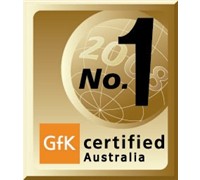Users who want to watch high definition movies while on the go should go to their nearest Aldi store in the next couple of weeks. This supermarket chain is about to offer a Blu-ray notebook that not only has noteworthy specifications, but also sports a price tag that is hard to beat. The Smarthouse Team takes a look at the MD97310 from Medion…

Click to enlarge |
The Medion MD97310 sports the same piano black exterior (still prone to fingerprints), keyboard layout, and brushed aluminium interior as the MD96940 (to hyperlink) we reviewed in April, although this 17-incher is packed with better specifications.
The MD97310 uses an Intel Core 2 duo T5800 processor running at 2.0Ghz, has 4GB of RAM, and uses Nvidia’s GeForce 8600M GS graphics card with 512MB GDDR2 memory. It also comes with a 320GB hard drive (Partitioned to Boot (271GB) and Recover (26GB)) for storing games, music, movies, and important documents.
The unit has an abundance of ports. The notebook comes with a 4-in-1 card reader, three different input and output jacks (microphone, headphone, and S/PDIF), an ExpressCard slot, an Ethernet port, a DVI-out port, an HDMI-out port, and four USB ports for optimum connectivity. The unit also has draft-N Wi-Fi built-in, giving users fast wireless connection anytime. The unit also comes with BD drive that plays Blu-ray discs, but more on that later.

Click to enlarge |
Opening the lid reveals a 17-inch WXGA screen with a maximum resolution of 1440×900 (16:10 cinema format), a 1.3-megapixel webcamera, a tactile keyboard with dedicated number keys, and a built-in microphone. What’s missing from this notebook is a set of dedicated multimedia hotkeys for easy access to Windows Media Player.
Medion has pre-installed Windows Vista Home Premium on the system and has included a suite of software for added home and office productivity. Programs include a trial version of Bullguard, Corel MediaOne and Draw Essential Edition 3, CyberLink YouCam, Google Desktop, Cyberlink Suite (MediaShow, PowerDirector, PowerDVD 8, PowerProducer), Microsoft Office Home and Student 2007 (Trial), Microsoft Works, and Nero 8 Essentials.
The unit’s built-in Blu-Ray drive allowed us to watch Blu-Ray movies on both our notebook’s screen (1440×900) as well as on our 46-inch LCD TV (Toshiba) via HDMI (1920×1080 resolution was possible). Our Blu-Ray copy of Close Encounters of the Third Kind loaded in 27 seconds (after loading the CyberLink DVD software) or 45 seconds to load from Windows. There were no dramas streaming content from the unit to the screen, although we encountered minor slowdowns and hiccups at times (around 2-3 instances where it just stopped to load).
While the unit cannot run hardcore games like Crysis, it can still handle recent games (like Command and Conquer: Red Alert 3) without any problems. The MD97310 got a score of 2540 in our 3DMark06 test and a Windows Vista overall rating of 4.7.
The unit lasted for 118 minutes in our DVD playback test, which is just about average for a 17-inch notebook. This would roughly equate to 3 to 4 hours of use when set to ‘economy’ mode. Despite having a subwoofer built-in, the audio quality is not worth writing home about, although it still gets the job done. If you want to have the best audio quality, then we recommend users to use the S/PDIF out port.
Medion’s MD97310 is a beefy notebook that brings high-definition content to your screen with its Blu-Ray drive. It may not be the best looking notebook around, but for $1,499, we think that it wouldn’t matter considering just what this notebook can offer. This new notebook will hit Aldi stores on November 20, 2008.
See page over for product specifications and final rating.
Medion Akoya MD97310 Specifications:
– Intel Core 2 Duo T5800 running at 2.0GHz.
– Nvidia GeForce 8600M GS with 512MB dedicated memory
– 320GB HDD
– 17-inch screen with maximum resolution of 1440×900 (16:10 cinema format)
– Wireless 802.11 b/g/n
– 4GB memory
– DVI and HDMI audio/video out
– 1.3-megapixel camera with built-in microphone
– Blu-Ray drive with DVD/CD writer
– Comprehensive software included (BullGuard, Corel MediaOne, Corel Draw Essential Edition 3, CyberLink YouCam, Google Desktop, CyberLink Suite (MediaShow, PowerDirector, PowerDVD 8, PowerProducer), Microsoft Office Home and Student 2007, Microsoft Works, Nero 8 Essentials)
– 6-channel audio out (Analogue + S/P-DIF)
– 4 in 1 Memory Card Reader (SD/MMC/MS/MS Pro)
– Speakers with built-in subwoofer
– Ethernet
– Windows Vista Home Premium With Service Pack 1
————————————
Medion Akoya MD97310 | $1,499 | 



 | www.aldi.com/au or www.medion.com.au
| www.aldi.com/au or www.medion.com.au
For: Noteworthy specifications; Built-in Blu-Ray drive; Abundance of software; Battery life
Against: Piano finish prone to fingerprints; No multimedia hotkeys; Occasional hiccups with Blu-ray player when hooked up to HDTV; Cannot handle ‘hardcore’ games; Gets really hot
Conclusion: Enter the world of Blu-ray with Medion’s new notebook.















